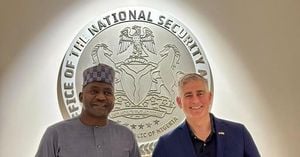As the 2025–2026 school year kicks off, education systems across the United States are bracing for a season of sweeping change, marked by new laws, evolving leadership, and shifting community priorities. Nowhere is this more evident than in New York City, the nation’s largest school district, and in Sioux City, Iowa, where school board elections and policy debates are shaping the future of local education.
In New York City, the back-to-school buzz is accompanied by a sense of both anticipation and anxiety. According to w42st, the city’s education system is navigating a complex web of reforms at the city, state, and federal levels. Families, educators, and administrators are all feeling the pressure as they adjust to new mandates, including a landmark class size reduction law, a citywide ban on student cell phone use, and ongoing curriculum reforms in reading and mathematics.
The class size reduction law, which took effect this year, requires that 60% of classes meet strict student limits—ranging from 20 to 25 students, depending on grade level. To make this possible, the city allocated $450 million to help 750 schools hire roughly 3,700 new teachers, supplementing the usual 4,000 to 5,000 hires each year. The hope, officials say, is that smaller classes will improve educational quality, enhance discipline, and boost teacher morale. However, the transition hasn’t been without its headaches. New teachers need training and support, and there’s fierce competition among schools for qualified staff. As w42st reports, “poor schools risk losing some teachers because wealthier schools are actively poaching staff.”
The challenge is only set to intensify. By the 2026–2027 school year, 80% of classrooms must comply with the new size limits—a goal that may be hard to achieve without building new schools. The city’s efforts to meet these requirements are being closely watched, as other districts across the country consider similar policies.
Meanwhile, a new citywide ban on phones and electronic gadgets has taken effect in all New York City schools. From bell to bell—including lunch and recess—students must surrender their devices, which are stored in locked cases or lockers. The city has invested $16 million to roll out the program, but enforcing it is proving tricky. Students are finding creative workarounds, such as bringing spare phones or using magnets to open locked cases. While violations don’t lead to suspensions, repeated noncompliance can result in disciplinary measures. Exceptions are granted for medical needs, translation, or special education, but as w42st notes, “full control is difficult to achieve.”
Immigration policy is also casting a long shadow over the city’s schools. In May, Immigration and Customs Enforcement (ICE) detained a student—Dylan Lopez Contreras—for the first time in New York City. Since then, several families have faced detentions and deportations, prompting concerns that fear of immigration enforcement could keep migrant children out of classrooms. As w42st points out, “the drop in immigration could have a serious impact on the system. In recent years, it has been new immigrants who have kept student numbers up.” International schools designed for newcomers may be especially vulnerable, but the ripple effects are likely to be felt citywide.
On the academic front, Mayor Eric Adams’ administration is pushing forward with curriculum reforms. All primary schools have already adopted new reading and math programs, and now about 100 middle schools in eight counties are required to switch to the new reading curricula. An additional 84 schools in six counties are joining the math program. City officials cite rising test scores as evidence of success, but the picture is nuanced. Gains have also been recorded in districts without the new programs and in charter schools, where improvements have been even more pronounced. As w42st observes, “the data show that there have been gains in districts without such programs, as well as in New York City charter schools, where scores have increased even more.”
Perhaps the most dramatic change is coming to high school graduation requirements. Starting in the 2027–2028 school year, the state will no longer require Regents exams for graduation. Instead, students will demonstrate their readiness through a variety of assessments, including debates, research projects, and community service. The new system aims to measure critical thinking, creativity, communication, global citizenship, and future planning. The specifics are still being hammered out, but officials hope the changes will better prepare students for life beyond high school.
While New York City grapples with these sweeping reforms, local governance and leadership transitions are front and center in Sioux City, Iowa. On September 4, 2025, Bobby Michaelson, a former teacher and coach now working in administration at Bishop Heelan High School, announced his bid for a second term on the Sioux City School Board. According to Siouxland Public Media News, Michaelson highlighted a “pretty powerful list” of achievements in recent years and voiced his desire to keep moving the district forward.
Michaelson underscored the importance of listening to staff and administrators, noting that “the main role of school board members is to let school administrators carry out their tasks, not to micromanage them.” He praised the district’s progress, especially the return of reading classes in middle schools, but acknowledged that more work remains in special education and English Language Learner programs. “The cabinet has made tremendous gains,” he said, “but more needs to be done in the areas of special education and English Language Learners.”
Two other board members—president Jan George and Dan Greenwell—also have terms expiring this year. Greenwell, who took out nomination papers on September 4, is considering another run, while George is expected to make a decision by mid-September. These contests are part of a broader wave of local elections across Iowa, with filing for school board, city council, and mayor positions open through September 18, 2025.
The developments in Sioux City mirror broader trends in American education, where local leadership, policy innovation, and community engagement all play critical roles. While the specifics differ from one district to another, the underlying issues—class size, curriculum reform, technology in schools, and the needs of diverse student populations—are shared across the country.
As the new school year unfolds, both New York City and Sioux City stand as reminders of the challenges and opportunities facing America’s schools. From sweeping legislative reforms to local elections that shape the direction of districts, the stakes have rarely felt higher—or the path forward more uncertain. Yet, in classrooms and boardrooms alike, the commitment to better serve students remains the common thread that ties these stories together.




